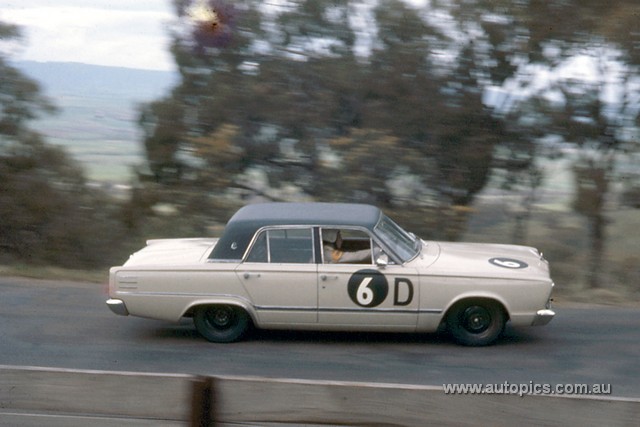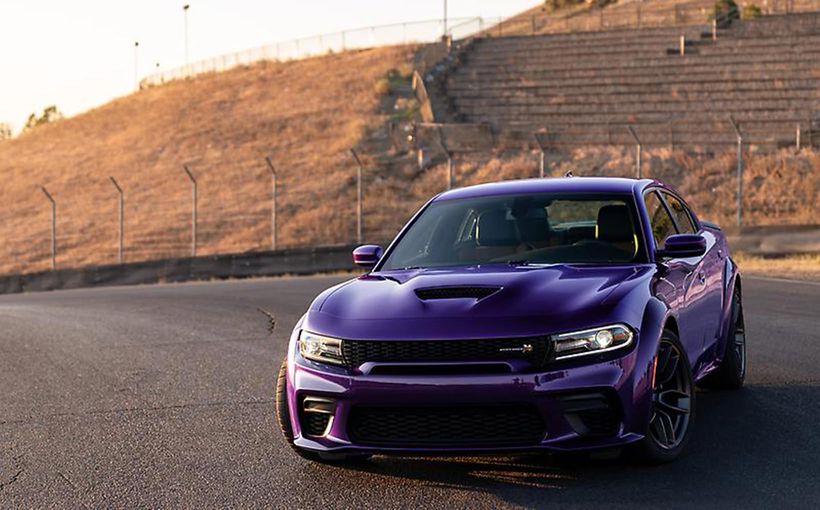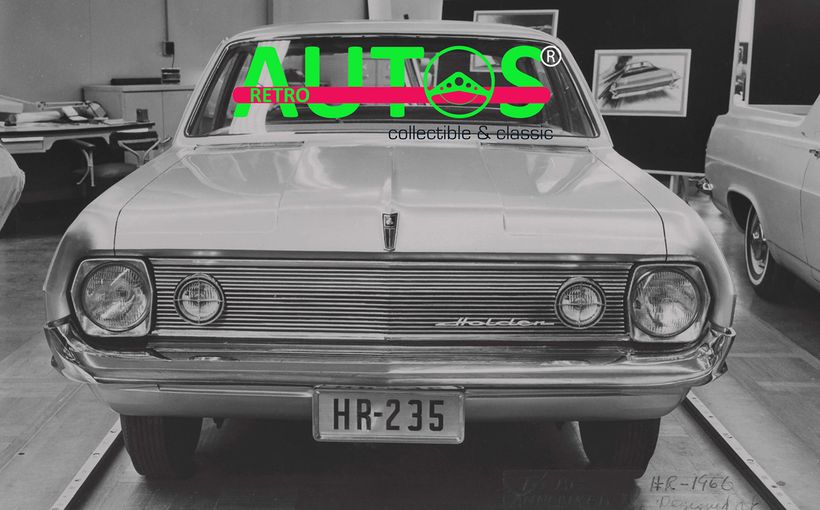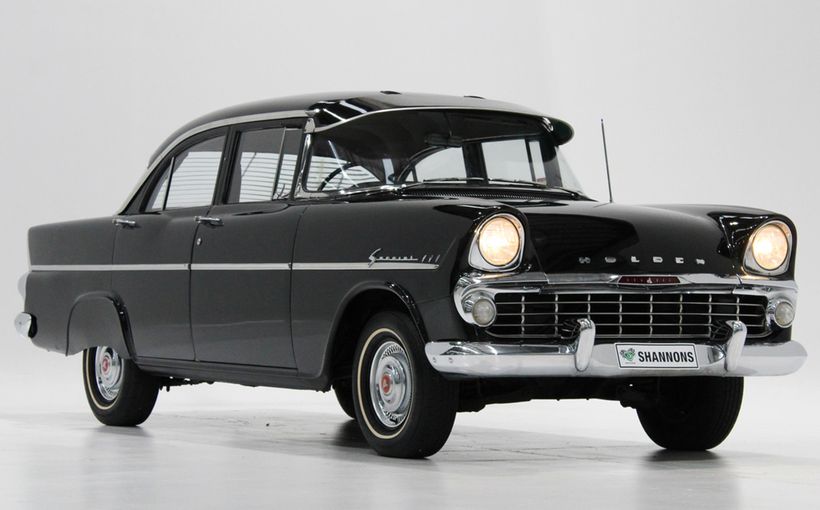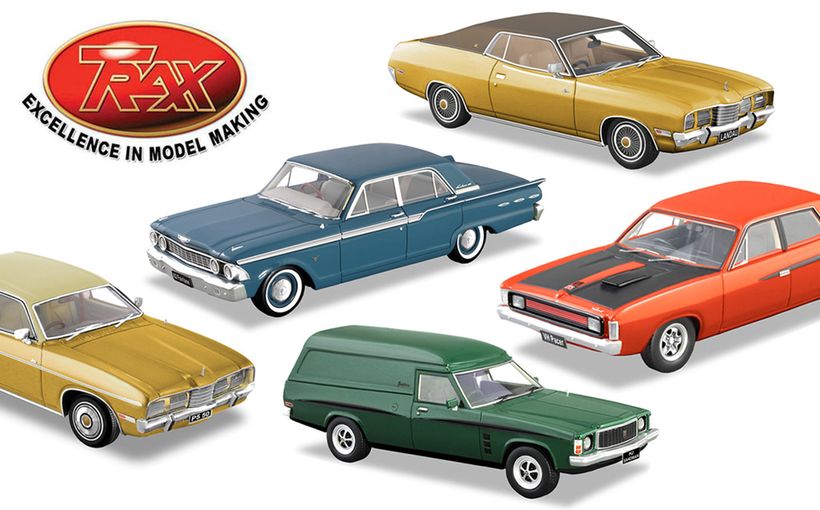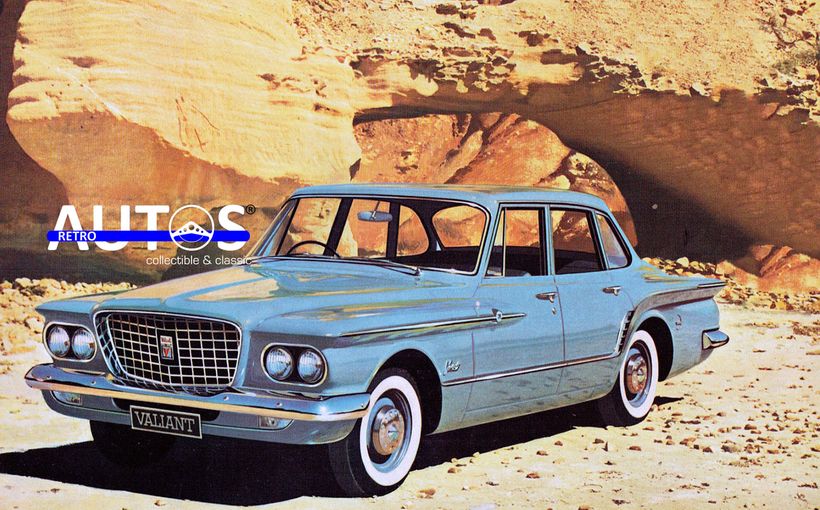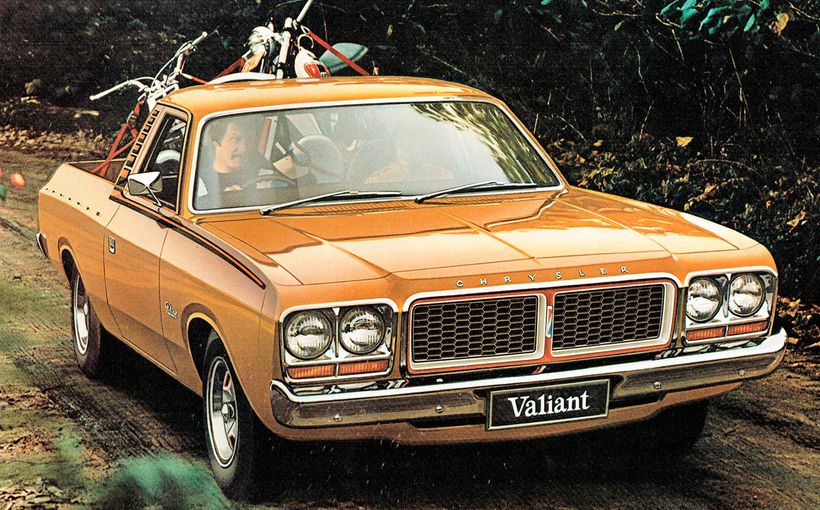1966 Bathurst 500: The Valiant V8 automatics that conquered The Mountain

The Boddenberg/Cooke VC Valiant V8 captured in full flight across the top of Mount Panorama. The V8 Valiants impressed with their speed and reliability over the 500 mile (800 km) race distance.
Chrysler Australia never built a V8 version of its hot Valiant R/T Charger, so the company’s Bathurst racing heritage has been built around its signature ‘Hemi’ six cylinder engine.
However, long before the Charger program kicked off in 1971, V8-powered Valiants did compete in the annual 500-mile Bathurst endurance race for stock standard road cars and enjoyed great success, even though few may be aware of that historic achievement today.
In 1966, a pair of the latest model VC Valiant V8s ran pretty much as they came off the showroom floor, complete with black vinyl roofs, three-speed automatic transmissions, four-wheel drum brakes and skinny radial tyres. The only showroom items removed were the hub caps.
They not only scored a resounding 1-2 in the big car division (Class D) but also 10th and 11th outright, making them the first non-Minis to finish behind a swarm of hot Cooper S entries that filled the first nine places that year.
Six cylinder Valiants had competed in the annual 500-mile race before, at both Philip Island and Bathurst, but the much trumpeted arrival of the 273 cid (4.5 litre) small block V8-powered AP6 in August 1965 suddenly raised the bar.
Chrysler Australia got a big jump on its local Ford and Holden rivals by launching Australia’s first compact V8 family car, without the usual ‘lead-tipped arrow’ handling traits of its American V8 cousins.

Minis, minis, everywhere! The size difference between the Valiants and dominant Minis is obvious here, as the Boddenberg/Cooke VC battles a pair of flying ‘bricks’ through Reid Park.
Its lusty 180 bhp, fully imported V8 was small and light, thanks to the latest thin-wall casting techniques used in the new LA (or Light A-series) engine family that resulted in only a slight weight increase over the company’s venerable 225 cid (3.7 litre) slant six.
And with Chrysler’s superlative water-cooled A904 Torqueflite three-speed automatic transmission bolted behind it, the new Valiant V8 represented a smooth yet very spirited sub-17 second performance package for the local Valiant buyer.
Little surprise then, that with its relatively light kerb weight and compact dimensions, the AP6 V8 also appealed to the helmet-and-gloves brigade who fancied their chances in the annual Bathurst 500.
Unfortunately, due to its release in August 1965, insufficient numbers of the new Valiant V8s had been built and sold to be eligible for the 1965 race.
However, no such problems existed for the 1966 event thanks to the new VC model being released much earlier in the year (March). The VC was basically a face-lifted version of the AP6, with new front and rear panels sets adapted to the AP6 centre section that gave the car a crisp and more sharper-edged appearance.
More than the minimum 250 VC model V8s were built and sold before entries closed for the 1966 race, making the latest V8-powered Valiant a hot favourite for victory in the big car division.

The Class D-winning Nougher/O’Keefe Valiant was one of two VC V8s entered. Here the dark-coloured car is under attack by a swarm of Cooper S Minis into Hell Corner. The rival Boddenberg/Cooke Valiant can be seen in the background.
There’s nothing quite like a V8
The 1966 Bathurst 500 attracted a new sponsor, with Irish tobacco company Gallaher replacing shock absorber brand Armstrong which had backed the race since its inception at Philip Island in 1960.
Australia’s currency switch to dollars and cents from pounds, shillings and pence meant new class structures for the ’66 race, comprising four divisions based on retail price groupings designed to encourage spirited competition.
Class A was for vehicles up to $1800, Class B ($1801-2040), Class C ($2041-2700) and Class D in which the Chryslers would compete ($2701-4000).
Two of the new VC Valiant V8s were entered in Class D, but they were entirely separate crews.
One was entered for Jack Nougher (aka Eiffeltower) and David O’Keefe with the other to be steered by Alton Boddenberg and Digby Cooke.
Cooke had by 1966 already faced the starter three times. In the first 500-mile race held at the Mountain in ‘63 he’d shared a Mini 850 with Tom Corcoran before starting an association with Alton Boddenberg, first in a Simca in ‘64 before sharing a slant six Valiant AP5 the following year.
“Alton Boddenberg’s father had a Chrysler and Hillman dealership on the NSW Central Coast called Gosford Motors,” Cooke told Shannons Club.
“That’s where we got the Simca from that we ran in ’64 and the six cylinder Valiant (AP5) that we ran in ’65 so by ‘66 we were ready to move up to the new V8 model.

How different did Mount Panorama look in 1966? This is the steep approach to Forrest’s Elbow with the track lined by open drainage ditches and exposed earth banks. Here the Boddenberg/Cooke Valiant is battling the lone Bob Young/Max Stewart Triumph 2000 and yet another Mini as it lines up for the Elbow.
“The previous year we’d quite enjoyed ourselves in the AP5 (eighth in Class C & 21st outright) and we thought the new V8 model was a pretty quick car, so we decided to enter it because they (Gosford Motors) could see some good sales promotion if the car did well.
“We were only aiming at a class win because we knew we wouldn’t be able to match the Cooper S’s in outright terms. They were so small and light compared to our cars. They had it all over us, but a class win was still a big deal in those days and worth having a crack at.”
In comparison to Class C, in which 17 of the 19 cars entered were the new Mini Cooper S, Class D boasted an intriguing mix of makes and models. In addition to the pair of VC Valiant V8s, there was the fast but fragile Studebaker Lark, a lone HD Holden X2 and Triumph 2000 plus a pair of Volvo 122S sedans. One of the Swedish cars was shared by future Bathurst 1000 winners John Harvey and Kevin Bartlett.
“We realised that we were one of a few cars in the class (along with the Lark and X2) fitted with four wheel drum brakes,” Cooke recalled.
“Chrysler had actually brought out a front disc brake option for the VC model but not enough of them had been built and sold to be eligible for the race. That was a real shame because if we’d had the front disc brakes the car would have been much faster.
“A story published at the time said that if we’d had disc brakes we actually could have been a bit of a threat (for outright honours) because we would have been several seconds a lap faster. With the drums, though, we had to nurse them along all day to make sure they could go the distance.”

The Nougher/O’Keefe Valiant lurches into The Dipper followed by one of the two Volvo 122S sedans also entered in Class D. The Swedish cars were no match for the superior V8 grunt of the latest Valiants.
Bathurst preparation - Series Production style
“The Valiant we drove was off-white with a black vinyl roof and from memory the other car (Nougher/O’Keefe) was a dark reddish-brown with a black vinyl roof,” Cooke recalled.
“Our car was brand new. It was taken straight off the showroom floor in Gosford and sent down to Ian Hindmarsh Motors in Sydney prior to the race.
“They went through the engine and tuned it up. They pulled the distributor out and set up all the spark (ignition advance) properly. They also pulled the carby apart and re-set all the float levels and things, but that was about it.
“They also fitted harder brake linings to cope with the heat the drums created under racing conditions, because you weren’t allowed to fit air scoops or open up the backing plates or do any of that.
“Castrol sent us out some heavy-duty transmission fluid from America that was specially made for the Torqueflite automatic and we were also sent a different oil seal for the front of the transmission because they were prone to blow a front oil seal under extreme conditions like racing.
“We used a special glycol-based engine coolant which had a higher temperature (tolerance) than plain water. We also fitted Michelin XAS radials which were the things to have back then but we didn’t lower the suspension or do anything else to the car. It basically raced as it came off the lot.”

A lovely 1960s period shot of the Boddenberg/Cooke Valiant V8 under heavy cornering load as it swings into Hell Corner. Mount Panorama really did look like a scenic country drive back then, didn’t it?
In qualifying, as expected the V8s ruled the roost in Class D with Warren Weldon taking his customary pole position in the booming V8 Studebaker Lark at 3 min 16.7 secs. Digby Cooke was second fastest and not far behind with a 3 mins 17.9 secs effort, just ahead of the Nougher/O’Keefe Valiant at 3 mins 18.3 secs.
The Valiant V8s had plenty of straight line punch, exploiting their extra grunt in the long climb up the Mountain and whistling down Conrod Straight at speeds exceeding 120 mph (192 km/h).
Even so, the swarms of Mini Cooper S’s in Class C were generally lapping in the 3.11- 3.13 time zone, making life hell for the wallowing big cars across the top and particularly under brakes. In fact, one of the Minis recorded such an astonishingly fast practice time that the race organisers suspected collusion on behalf of the Valiant V8.
“We had a lot of enjoyment driving that car, with all the power it had,” Cooke recalled cheekily.
“I do remember in practice quickly catching up to a good mate of mine, Bill Stanley, in his Cooper S (finished second outright) going up the Mountain and his lap time dropped by a ridiculous amount, like about eight seconds, because I shoved him all the way to the top!
“Jack Hinxman from the ARDC pulled me aside after that and said: “that Mini you were following did an amazing lap time, an extraordinary lap time, so if I catch you doing that again during the race I will black-flag you!”

Moments after the start of the ’66 race and the booming V8s lead the huge field into Hell Corner, led by Warren Weldon’s Studebaker Lark with the fast-starting Nougher/O’Keefe Valiant close behind.
The Race
In the early years of The Great Race the big cars would start at the front, on the basis that the biggest and most expensive cars were logically the fastest. The swarming pack of Cooper S Minis starting just behind them would soon debunk that theory!
The Weldon/Slattery Studebaker leapt off the line with the two Valiant V8s and the other Class D contenders in hot pursuit, but it wasn’t long before they were being dive-bombed by the little ‘bricks’ in Class C that were here, there and everywhere.
Within the space of a few laps the big cars had already run out of answers to the superior speed of the menacing Minis, which ran off into the distance in their battle for outright honours. However, behind them another great battle was unfolding.
“There was a remarkable fight going on amongst the big cars in Class D,” reported the doyen of Bathurst historians Bill Tuckey in Australia’s Greatest Motor Race. “The two Valiants led the class for more than an hour, Nougher surviving a side-swipe by John French (Mini) and the two Chrysler V8s displaying much better handling and braking than anyone had expected.
“But the sheer persistence and experience of Weldon (Studebaker) put him into second place after that first hour and the race was really between those three, with the Bartlett/Harvey and Lister/Porter Volvos far too slow.

It’s perhaps not surprising that the front wheel bearing failed on Cooke’s Valiant when you see how heavily loaded that right front corner was, particularly here through the punishing Dipper being hounded by a trio of Minis.
“Weldon got into the lead on the first pit stops but O’Keefe soon put the Valiant back into the class lead. Then at 1.20pm the Weldon/Slattery car came in with no second gear and was to limp to the finish.
“At 1.30pm Digby Cooke got his Valiant up into first place. The lead changed again when the Savva/Taylor X2 Holden got in front of the two Valiants on pit stops, but with 20 minutes to go and the (Valiant) V8s hammering on the boot, the Holden blew up in a cloud of smoke on Conrod.
“The class win went to Nougher/O’Keefe on German Fulda tyres followed by Cooke/Boddenberg on Michelins.”
Cooke told Shannons Club that the reason he lost the class lead in the early afternoon and dropped two laps behind their Valiant rivals was due to a relatively minor mechanical gremlin that took a long time to fix.
“We were a lap or two ahead when we had to come in to replace the right front wheel bearing. They were a little susceptible to that and we were warned it could happen, because the right front wheel is the most heavily loaded on the car and cops a real hammering around there. We dropped a lot of time in the pits changing that bearing.
“We also had to change the front brake shoes at one stage and both front tyres from what I can recall, because she was leaning pretty heavily on the left front as well. They were Michelin road car radials but we didn’t buff the treads down or do anything like that. They were just straight off the shelf like everything else on the car.

Whoa! Cooke had a frightening moment during the race when his car left the track and almost rolled. Digby can’t recall if it was caused by the front wheel bearing problem, but he did well to recover from this excursion without damaging the car.
“Apart from the wheel bearing, we didn’t have any other mechanical problems although I did have a bit of a moment at Hell Corner one lap when I went in too hot and almost rolled the thing! At the end of the day, the car was spot-on. There was nothing wrong with it.”
Cooke and Boddenberg drove a disciplined race, using the generous 260 ft/lbs (351 Nm) of torque from the 4.5 litre V8 to gallop up the steep Mountain each lap and relying on the tough Torqueflite transmission to assist on the way down.
“We were using the gearbox to help slow the car by using engine braking at the end of Conrod (Straight) to save wear on the front brakes,” Cooke explained.
“Coming up to the first brake markers (about 400 metres out) I was pulling it back to ‘2’ at 95 mph (150 km/h) to help slow it down for Murray’s, then shifting it back up to ‘D’ when I got onto Mountain Straight again at about 90 mph.

By comparison to today’s fat racing rubber, the Valiant V8’s Michelin radials look like bicycle tyres. With good preparation and disciplined driving, the Valiant V8s were the highest placed non-Minis in the race. The first time Cooke drove this car was in practice for the race!
“I’d also change down to ‘2’ on the approach to The Cutting to get good acceleration out of there because it was so steep and also coming down through The Esses, before shifting back up to top on Conrod.
“It was like a floating block of flats to drive. The handling was, to say the least, very sloppy because the springs and shock absorbers were all standard and the steering felt like it had about 18 turns lock-to-lock.
“We weren’t allowed to change anything inside the cars in those days, so we spent the whole day sliding around on the standard vinyl seats. Alton and I had to lean heavily on our left knees (against the centre console) to brace ourselves through the right-handers and then lean heavily on our right knees against the door through the left-handers. So your knees were pretty sore by the end of it.
“It had bucket seats, but they were covered in smooth vinyl and they were quite wide and flat without the big side bolsters they have today. You were all over the car. The best thing was the steering wheel because you could actually use it to hold yourself in place!”

One of the greatest challenges for drivers racing stock standard road cars at Bathurst was keeping themselves upright in the seat. Here the Boddenberg/Cooke VC V8 hammers through The Dipper, with the driver hanging onto the steering wheel for some much needed support.
Looking back
After more than seven hours of racing, the Nougher/O’Keefe Valiant V8 crossed the finish line to win Class D, followed by the Boddenberg/Cooke entry two laps behind in second place.
A sobering comparison of the competition that day can be seen in the performance of the outright-winning Mini Cooper S driven by Bob Holden and Rauno Aaltonen, which led home another eight Cooper S entries on its way to completing the 130 lap distance.
The top-placed Valiant V8 in 10th outright finished six laps behind; the Doddenberg/Cooke Valiant was eight laps down.
Even so, the two Valiant teams and a Hillman Minx (Class B) driven by Lionel Ayers and Max Volkers unwittingly became joint winners of a manufacturers’ team prize - the PBR Trophy - which they knew nothing about until it was awarded to them.
After the Valiant V8’s impressive performance, Gosford Motors exploited the ‘Win on Sunday, sell on Monday’ effect that Bathurst class wins had on car buyers in those days. And the Doddenberg/Cooke entry returned to a more humble way of life, like so many dealer-supplied Bathurst race cars of the showroom stock era.
“Our car went back to Gosford Motors after the race, got a wash and a quick detail and was sold as a demonstrator,” Cooke recalled. “The buyer would have been none the wiser about its Bathurst history, of course, but I reckon they would have had the quickest V8 Valiant in Australia!”
Protect your Chrysler. Call Shannons Insurance on 13 46 46 to get a quote today.

